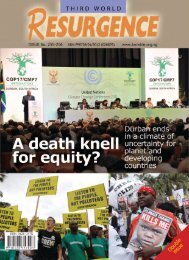Plantations, poverty and power - Critical Information Collective
Plantations, poverty and power - Critical Information Collective
Plantations, poverty and power - Critical Information Collective
You also want an ePaper? Increase the reach of your titles
YUMPU automatically turns print PDFs into web optimized ePapers that Google loves.
117<br />
failure to define industrial tree plantations are clearly revealed. FAO can pretend that it is aiming to help<br />
“owners of small forest areas”, when in fact it is helping the owners of industrial tree plantations: large<br />
multinational corporations.<br />
FAO explains that its guidelines are to be voluntary. FAO set up no system for determining whether a<br />
particular project complies with the guidelines <strong>and</strong> even explains that the guidelines are to be interpreted<br />
differently, depending on the level of industrialisation within the country involved:<br />
“The underst<strong>and</strong>ing <strong>and</strong> application of the principles <strong>and</strong> recommendations will be determined by the<br />
prevailing governance, economic, cultural, social, environmental or other contexts. The extent to which<br />
country economies are industrialized, in transition or developing will determine the application of each<br />
principle.”604<br />
This is an extraordinary statement. It implies that different st<strong>and</strong>ards would apply in, say, Laos, Brazil<br />
<strong>and</strong> Germany, because of the different level of industrialisation in each country. FAO gives no<br />
explanation for this, nor does it explain exactly how the level of industrialisation is supposed to determine<br />
how each principle is to be applied.<br />
The guidelines consist of 12 Principles, divided into five sections: Institutional; Economic; Social <strong>and</strong><br />
Cultural; Environmental; <strong>and</strong> L<strong>and</strong>scape approach. A series of guidelines follows each Principle. But the<br />
guidelines provide no advice about whether all the Principles <strong>and</strong> guidelines should be met, or just some<br />
of them, some of the time. FAO provides no advice on interpreting the guidelines or who should do the<br />
interpreting.<br />
The assumption behind the guidelines is that plantations should go ahead. Principle 1, on “Good<br />
governance”, states that governments “should facilitate an environment of stable economic, legal <strong>and</strong><br />
institutional conditions to encourage long-term investment, sustainable l<strong>and</strong>-use practices <strong>and</strong> socioeconomic<br />
stability.” Principle 5, on “Enabling environment for investment”, states that “Governments<br />
should create the enabling conditions to encourage corporate, medium- <strong>and</strong> small-scale investors to make<br />
long-term investments in planted forests <strong>and</strong> to yield a favourable return on investment.”<br />
Some of the guidelines are progressive. Principle 2, on “Integrated decision-making <strong>and</strong> multistakeholder<br />
approaches”, recognises the principle of free prior <strong>and</strong> informed consent: “respecting international law to<br />
ensure that local communities <strong>and</strong> indigenous peoples retain control over their l<strong>and</strong>s, unless they delegate<br />
control with free, prior <strong>and</strong> informed consent.” Principle 8, on “Maintenance of social <strong>and</strong> cultural<br />
services”, states that governments should prevent “displacement or resettlement of communities without<br />
free, prior <strong>and</strong> informed consent”.<br />
Other guidelines are written in a bureaucratic style that is difficult to underst<strong>and</strong>. For example, Principle 2<br />
states that the guidelines should include “[I]ntegrating policies, planning <strong>and</strong> management decisionmaking<br />
related to planted forests into intersectoral <strong>and</strong> multidisciplinary approaches in order to reflect<br />
their role in the wider l<strong>and</strong>scape, both spatially <strong>and</strong> temporally”. It is difficult to know what this means,<br />
or what impact of plantations it is attempting to address. Determining whether or not it has been<br />
implemented in practice would be pretty much impossible.<br />
604 FAO (2006) “Responsible management of planted forests: voluntary guidelines”, Planted Forests <strong>and</strong> Trees Working<br />
Paper 37/E, UN Food <strong>and</strong> Agriculture Organisation, page 9. http://www.fao.org/docrep/009/j9256e/J9256E00.htm















